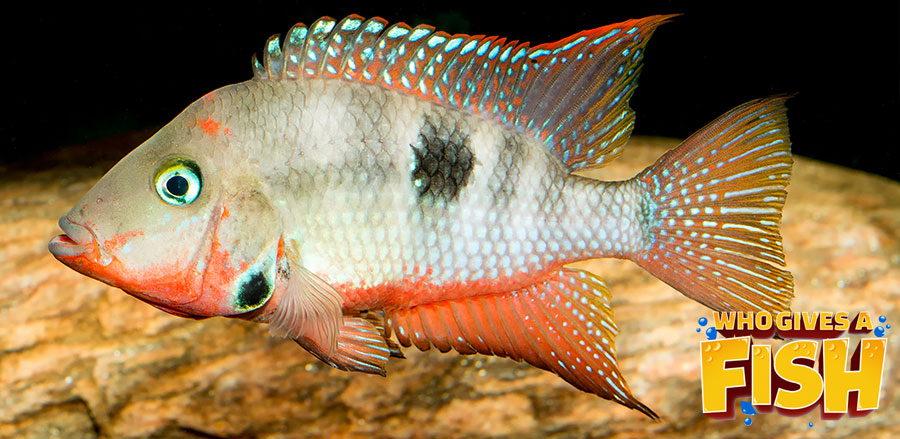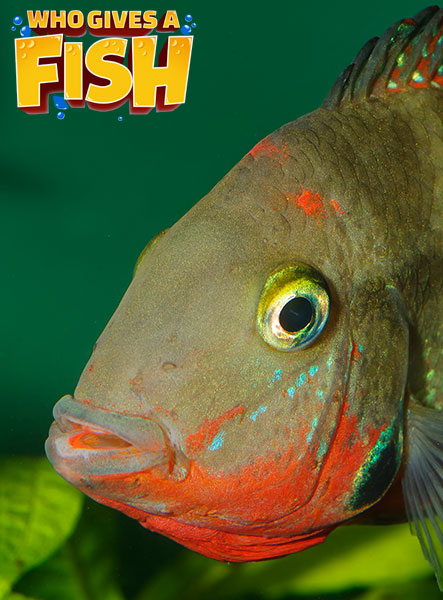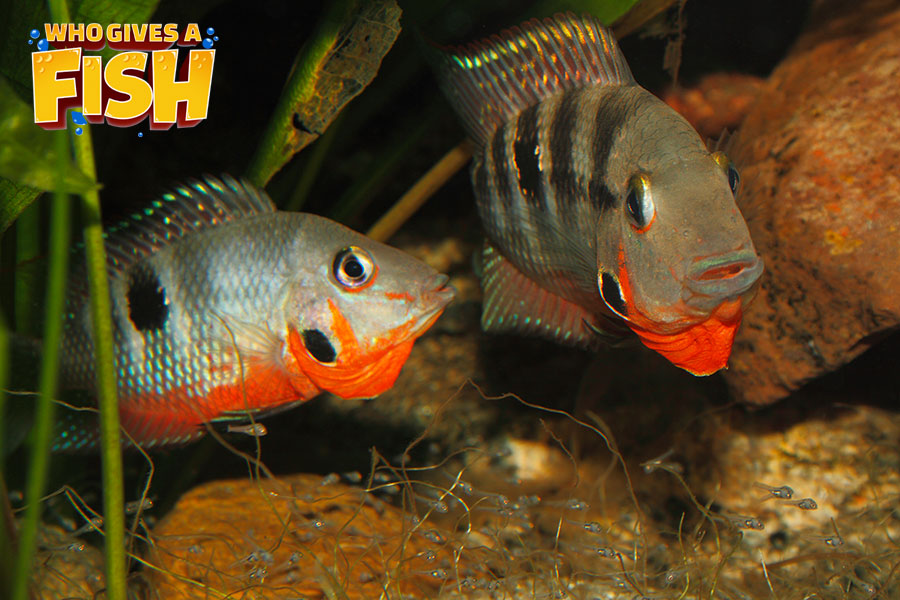Firemouth Cichlid
The Firemouth Cichlid, Thorichthys meeki, is one of the hobbies favorite Cichlids. It’s gorgeous coloration and hardiness are two of the main reasons this fish is so popular.
Their teardrop shape make them fantastic swimmers and full sized ones will certainly put your rock work to the test when they decide to break out of their usual calm behavior. They owe their name to the obvious coloration under their throat, which can extend right underneath the fish all the way to the tail.
- Experience Level: Beginner
- Hardiness: Very Hardy
- Minimum Tank Size: 30 gal (115 L)
- Maximum Size: 7 in. (17.8 cm)
- Temperament: Semi Agressive
- Temperature: 70 – 76° F (21.1 – 24.4° C)
- pH Range: 6.5 – 8
- Water Hardness: 8 – 15dGH
- Diet: Omnivore
Table of Contents
Introduction
Aquarium Setup
Difficulty
Feeding
Breeding and Social
While this Cichlid can display some aggression, it is generally considered to be peaceful with others. Keeping the Firemouth with other Firemouth and similar Cichlids is a better option for tank aggression planning.
As with most fish, especially Cichlids, their aggression will rise significantly during spawning, especially around the breeding site.
This is another “burrowing Cichlid” in that they will dig out your rockwork and substrate to make themselves a shelter/cave. Don’t count on your aquascaping remaining the way you placed it! You should ensure that any plants you introduce are well anchored down as this fish will likely pull them out.
Aquarium Setup
The Firemouth Cichlid demands at least 30 gallons if kept in a pair, but for any more fish you will need 55 gallons plus. Usual high quality filtration in the form of a sump or canister filters are required to ensure water quality and proper bacterial colonies. This species appreciates areas with good flow and will often play in currents from water outlets.
As previously mentioned, this Cichlid will rearrange your aquascape and you would be best advised to securely fasten all movable objects in your tank and anchor any plants down. Failure to do so will likely result in a completely different look in the morning. Your rock work should include many caves and hiding areas in order to help prevent redecorating.
Like many Cichlids, the Firemouth can tolerate slightly brackish water conditions due to the high mineral and salt content found in its natural habitat. A typical brackish tank, however, is not suitable.
Firemouth Cichlid Aquarium Guide
- Minimum Tank Size: 30 gal (115 L)
- pH Range: 6.5 – 8
- Water Hardness: 8 – 15 dGH
- Temperature: 70 – 76° F (21.1 – 24.4° C)
- Lighting: Moderate
- Substrate: Sand/Fine Gravel
- Brackish: Slightly, standard Brackish tanks are not suitable.
- Water Flow: Moderate. likes currents from water outlets.
- Tank Region: Mid to bottom.
Difficulty
Given their hardiness and ability to adapt to many different types of aquarium setups and water conditions, the Firemouth makes a great fish for any level aquarist.
Like many Cichlids, the Firemouth will give you difficulty in maintaining your aquascape in the way that you originally placed it. This is especially troublesome with full grown specimens and it is highly advised to securely fasten your rock work and to anchor all plants.
Other than spawning times where they can display aggression, they are generally otherwise known as peaceful fish. They do produce a large bioload so ensuring your filtration is nothing but excellent.
Feeding
These Cichlids are not fussy eaters and will take almost anything you give them. Like all fish, a varied diet is important and the Firemouth will strive off a diet of specific Cichlid Pellet and Flake foods as a base. To supplement these foods, offer slightly cooked cucumber finely chopped, along with dark leafy green such as spinach.
Occasional meaty foods such as animal hearts, livers, brine shrimp and blood worms are encouraged as they will benefit from the proteins. Feed several times per day, and in small amounts.
Firemouth Cichlid Feeding Guide
- Diet: Omnivore
- Frequency: Several times per day in small amounts.
- Pellet Foods: Yes, Cichlid specific products.
- Flake Foods: Yes, Cichlid specific products.
- Live Foods: Yes, these include shrimp, worms and smaller fish.
- Meat Foods: Occasionally, animal heart, liver, and other meaty foods such as brine shrimp.
- Vegetable Foods: Yes, slightly cooked dark leafy greens are a great addition to their diet.
Breeding
The Firemouth males dorsal and anal fins are usually more pointed and their coloration is noticeably stronger than the females. During spawning periods the coloration becomes even stronger.
This Cichlid is very easy to breed. The female Firemouth will lay her eggs, where they are fertilized and remain until hatching. Both male and females will remain on guard and closely monitor the eggs which can range in numbers of 100 to as high as 600.
If you are intentionally breeding the Firemouth Cichlid, you would be best to ensure your pH levels are fairly neutral, around 7.0 and that your water hardness is increased to around 10 to 11 dGH. An increase in temperature to around 78° F (25.5° C) will also promote spawning.
Approximately 7 days after being laid, the fry will hatch and become fish food if not removed from a community tank. The adult pair will vigorously try to round them up and keep them together in order to protect them, but stragglers will escape and become food. If you intend to keep the fry, it would be best to raise them in a separate fry tank, and the female can also be placed with them in said tank.
A breeding pair can produce young several times per year.
Social
Firemouth Cichlids are generally peaceful fish except on occasion when spawning and protecting their young. They are suitable for most non aggressive community tanks and do well with their own species.
The pairs are monogamous and will remain as a pair for most of their lives. They will defend their young relentlessly, attacking and killing any fish that persist in harassing the young and/or nest.
While you can keep multiple pairs per tank, it would be advised that at least 50 gallons per pair is met. This should provide ample space to avoid territory problems.




